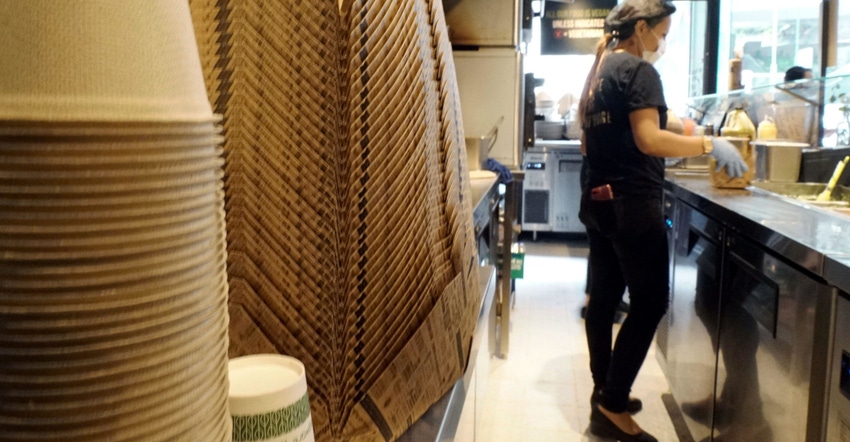Your sustainable packaging choices should work for your business, your customers, and the communities you serve.

Sustainability has become a catch-all term, and it has created lots of confusion on the part of foodservice providers and consumers alike.
To some, being sustainable translates to “going green,” which itself is a vague term, but meant to convey reducing or eliminating pollution. To others, being sustainable means, more specifically, avoiding the depletion of national resources. In many cases, including the world of foodservice and food packaging, these terms can be contradictory. However, when more than half of Americans say they are “extremely or very concerned about the environmental impact of product packaging,” it requires those in the foodservice world to take action.
Today, choosing the right food packaging is increasingly becoming one of the biggest ways restaurants and other foodservice providers can increase their sustainability efforts. In fact, the right food packaging can not only reduce a business’s impact on the environment but in turn help consumers reduce their impact as well. By providing customers with sustainable food packaging options, they can feel better about the choices they make regarding their food purchases.
But selecting the right “sustainable” food packaging isn’t as simple as it sounds. It’s not just a matter of pulp/fiber vs. plastic. The decision is considerably more complex.
Here are five considerations for selecting food packaging that makes your business and your customers more sustainable.
1. Setting sustainability objectives.
Prior to making any determinations on food packaging, it’s important to first set your organization’s sustainability goals and initiatives that can drive not only food packaging choices but all organizational decisions. Selecting between fiber or plastic food packaging (and weighing the pros and cons of each) is much tougher when there aren’t sustainability objectives in place to guide these decisions.
If your company goals are to reduce food waste, you may want to go in the direction of plastic. If you want to limit what packaging ends up in a landfill, it might require compostable fiber packaging. If your goals are to reduce energy usage, water usage, or greenhouse gas emissions, you may want to consider plastic again. As we’ll get into later, searching for that perfect food packaging option can be a fool’s errand, so it’s critical to have some sustainability goals in place that can guide the choices you make.
2. Focus on features and fitness for use.
Let’s face it — the perfect package does not exist. At least today, there is not one packaging solution that is an ideal vessel for your foods while also delivering zero impact on the environment in one way or the other. There will always be drawbacks to certain products and tradeoffs to consider. To choose the right food packaging, start with examining fitness for use and then work your way through the decision tree.
What is the food type I’m looking to package? Is it stored or is it served fresh? What temperature is it, and will it be refrigerated, frozen, or heated? How long should it last after leaving the establishment? Answering a few of those questions first will narrow down the packaging options, and decisions can then be made about what sustainable options make the most sense for the food product and your sustainability goals.
For example, after you determine the factors that would make an appropriate packaging solution, you may find that either one of fiber packaging or plastic packaging would be more suitable for your food needs. And while plastic options may not have been your first choice, your food may be able to be stored for longer durations and lead to a reduction in food waste (which we’ll talk about shortly).
Again, there will always be tradeoffs to consider and weigh. And it’s part of the reason it’s important to work with food packaging suppliers who have a variety of options in fiber and plastic that can help you decide what’s best for you and your customers.
3. Diagnose disposal.
Nearly all food packaging will be disposed of in some form. Whether that disposal comes in the form of recycling the packaging, composting it, or tossing it in the waste bin should be weighed based on local recycling/composting infrastructure and likely customer habits. There are positives and negatives to each approach, and it’s important to conduct a full lifecycle analysis before selecting the packaging for your food products.
Compostable fiber packaging does require more water and energy to produce, yet it doesn’t create waste — when disposed of properly where composting facilities exist. Plastic packaging requires much less water and energy to produce but most options aren’t easily recycled and often end up in a landfill. So, while the front-end manufacturing of fiber-based products may be more energy intense, the disposal impact is lower than plastic alternatives. The opposite is the case for plastic packaging. As mentioned earlier, there will always be tradeoffs to consider, and production vs. disposal impact is yet another.
4. Look beyond legislation.
Legislators at the state and federal level are not experts in food packaging, and they’re very likely not experts in sustainability. Certainly, they have environmental organizations and lobbyists in their ears who can educate them about the benefits and drawbacks of particular environmental matters, but they are often making decisions on regulations without knowing the intricacies of food packaging. This means that if a foodservice provider wants to truly make sustainability advancements, it may require not necessarily ignoring legislation, but rather going a step further.
To truly be a leader, businesses should rely less on legislation to be their sustainability compass and instead turn to experts in food packaging to set the course for sustainability. Often, manufacturers will anticipate future regulation or societal trends and step ahead of the regulatory curve on green initiatives. Work with your food packaging supplier to choose options that exceed the bare minimum allowed by government. Your customers will likely thank you for it.
5. Waging war on waste.
According to the United Stated Department of Agriculture (USDA), it’s estimated that between 30-40% of the US food supply is wasted. This staggering number equates not only to significant costs (more than $160 billion annually but means wholesome food cannot get to families in need and is instead sent to growing landfills, leading to higher carbon emissions.
One of the most effective ways for people to reduce their food waste — and do so without changing their habits much at all — is through food packaging. The right food packaging can help increase the shelf life of food and lead to both a reduction in wasted food and also more satisfied customers, who don’t have to throw away uneaten or partially eaten food that’s gone bad. While plastic options are currently superior to fiber and pulp options when it comes to preserving food, choosing the right packaging can have a dramatic effect on consumers’ food waste and increase an individual’s sustainability efforts at the home or office.
Choosing the right food packaging isn’t as easy as it once was. In this era of the environmentally conscious consumer, it requires proper sustainability planning. And it demands working with a food packaging manufacturer with a diverse collection of solutions that can guide you through the selection process. As you begin to consider your food packaging options, be sure to make selections based on what works for your business, your sustainability goals, your community, and your customers’ habits.
Robert Beagan is Director of Sustainable Growth Platforms for Sabert Corp. where he is responsible for charting the company's future growth in plant-based packaging.
About the Author(s)
You May Also Like




